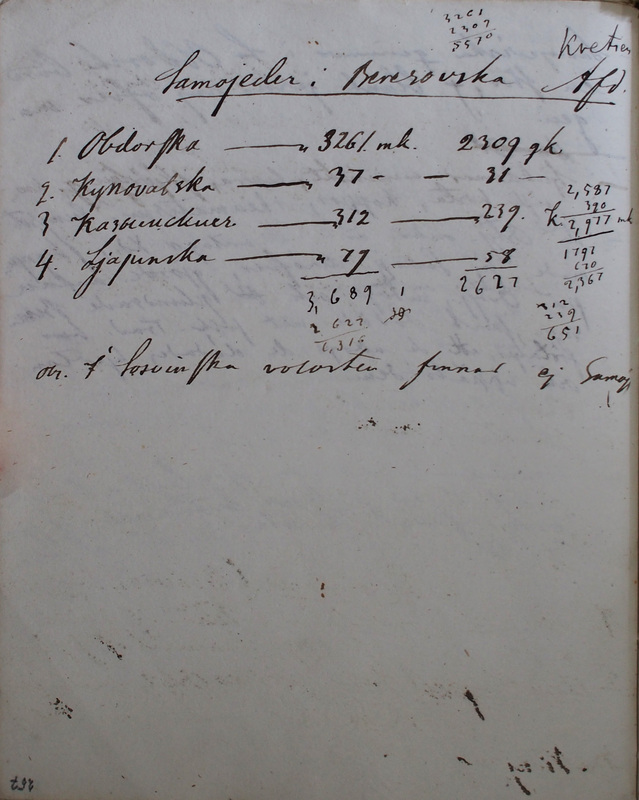Ethnographiska, historiska och statiska anmärkningar. 257
Title
Ethnographiska, historiska och statiska anmärkningar. 257
Description
Samojeder i Beresovska Afd[elningen]. kretsen
Samoyeds in the Berezov uezd
See [Berezov uezd].
|
1. Obdorska |
3261 mk.[mänskliga] |
2309 qk.[qvinnliga] |
|
2. Kynovatska Ky[u]novat
Here Kunovat refers to an administrative area, the Kunovat volostʹ. Kunovat is an old town, situated on the bank of the River Kunovat and already known in sources from the 16th century. The town was the centre of the Kunovat princedom, which had close contacts with other princedoms of the Berezov uezd. Later, it served as a centre of the Kunovat volostʹ. The Nenets of the area were Forest Nenets speakers. (Bachrušin 1935: 6–7, 37, 66–68; Alekseev (ed.) 2010: 237–238)
|
37 |
31 |
|
3. Казымскихъ Kazym
Here Kazym refers to an administrative area, the Kazym volostʹ. Kazym is a town situated on the bank of the River Kazym and already known in sources from the 16th century. The town was a centre of the Kazym princedom and a significant centre of trade between the Khanty and Forest Nenets. The Nenets of the area were Forest Nenets speakers. (Bachrušin 1935:18, 68–69; Alekseev (ed.) 2010: 237–238)
|
312 |
239 |
|
4. Ljapinska Ljapin
Here Ljapin refers to an administrative area, the Ljapin volostʹ. Ljapin is a town situated on the bank of the River Sygva and the town, together with the Ljapin princedom, is already known in sources from the 16th century, and it was one of the largest princedoms of the Berezov area in the 17th century. The Nenets of the area were Forest Nenets speakers. (Bachrušin 1935: 7, 66–68; Alekseev (ed.) 2010: 237–238)
|
79 |
58 |
|
total |
3689 |
2627 |
Obs. I Sosvinska volosten finnas ej Samoj[eder].
NB: There are no Samoyeds in the Sosva volostʹ.
Sosva refers here to an administrative area, the Sosʹva volostʹ. The town of Sosva served as the centre of the fomer Sosva princedom, and as the princedom itself fell, Sosva became known as one of the major religious centres with an idol (šaitan) that was visited by neighbouring Khanty. The indigenous people were mostly speakers of Mansi, but also Khanty. (Bachrušin 1935: 7, 30–31; Alekseev (ed.) 2010: 237–238)
[[the page is upside down]]
[[the page is upside down]]

